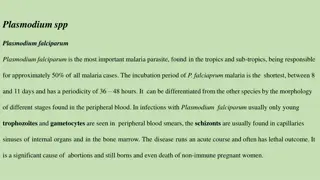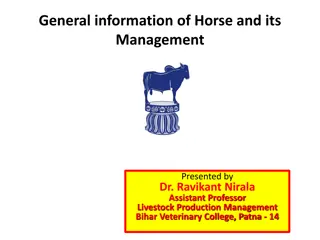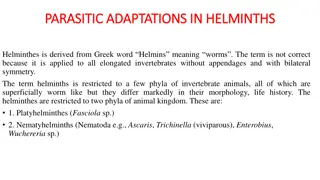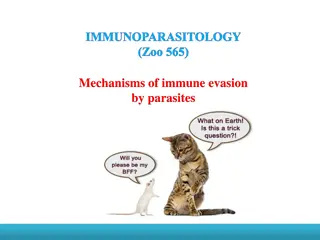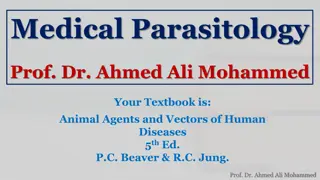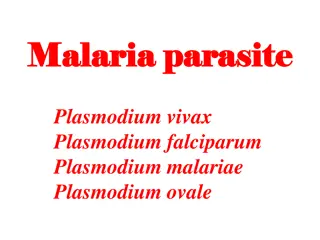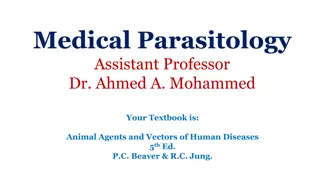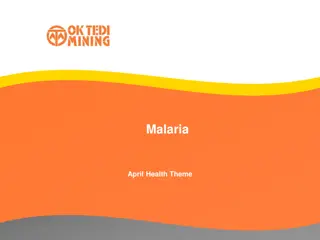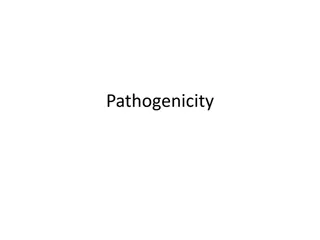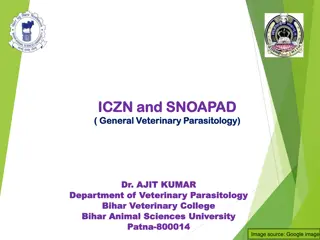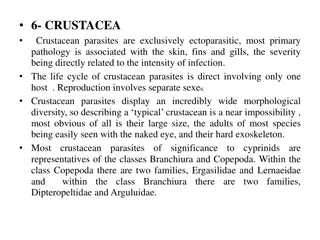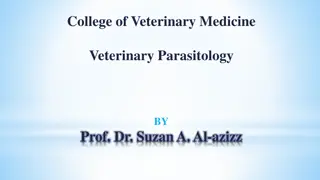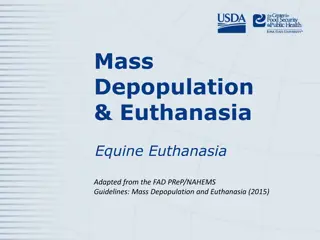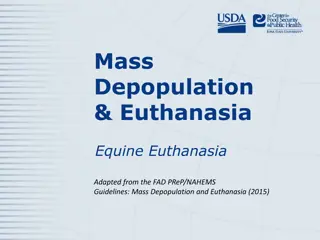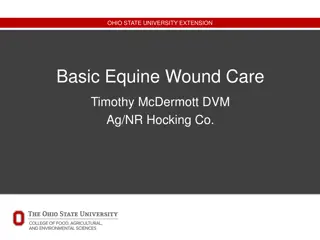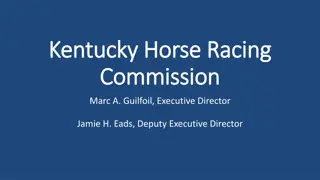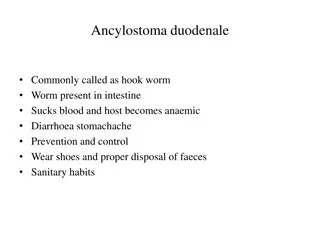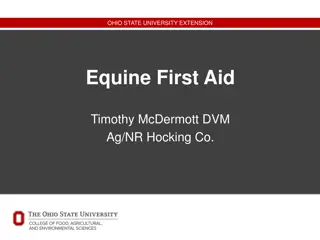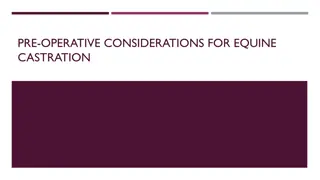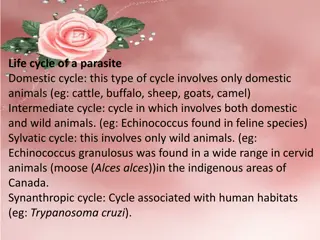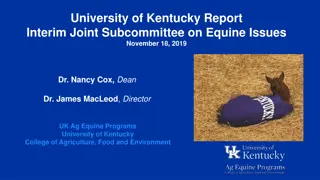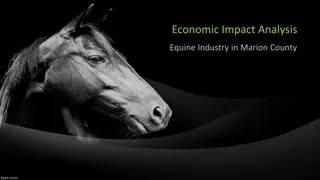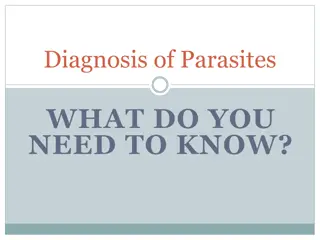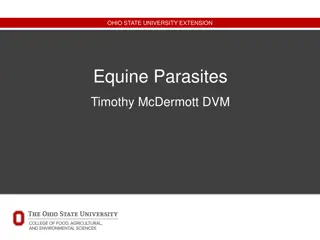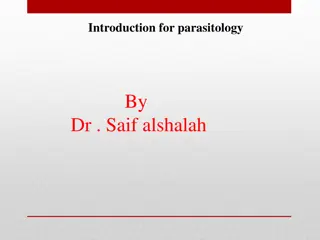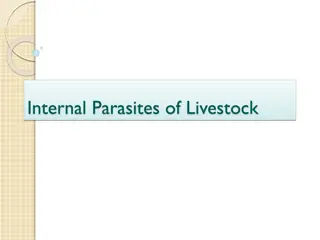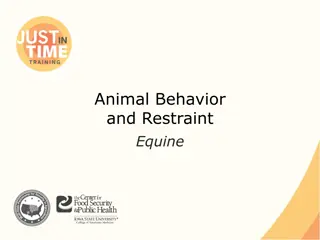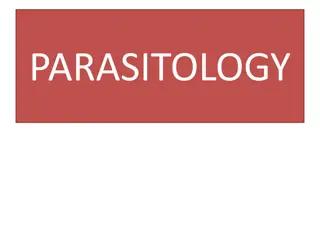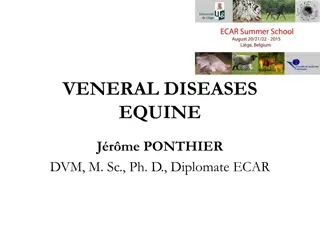Overview of Plasmodium falciparum and Plasmodium vivax Malaria Parasites
Plasmodium falciparum is the most significant malaria parasite, responsible for about 50% of cases, with a short incubation period and distinct morphology in blood smears. It causes severe symptoms and complications, affecting various organs. In contrast, Plasmodium vivax is the most common malaria
2 views • 7 slides
Understanding the Hookworm Superfamily Ancylostomatoidea
The superfamily Ancylostomatoidea includes blood-feeding parasites like hookworms, with important species such as Ancylostoma caninum in dogs and Ancylostoma duodenale in humans. These parasites have a complex lifecycle involving transmission through the environment and development within the host.
0 views • 31 slides
The Origin of Viruses: Theories and Evidence
Viruses are acellular parasites with a complex replication mechanism. Studies on their origin present challenges due to the lack of fossils. Three main hypotheses include regressive, cellular origin, and co-evolution. The regressive hypothesis suggests viruses originated from complex ancestors that
2 views • 25 slides
Horse Management and Common Terminology Overview
Dr. Ravikant Nirala, Assistant Professor at Bihar Veterinary College, presents comprehensive information on horse management and common terminology associated with equine production. The content covers the position of horses in the animal kingdom, terminology for different horse genders and ages, mi
1 views • 15 slides
Adaptations in Helminth Parasites: Structural and Morphological Changes
Helminth parasites exhibit adaptations for successful living within hosts, involving structural modifications such as degeneration and new organ formation. Parasitism has evolved over time, leading to a dependent relationship between parasites and hosts. The adaptations in locomotory, digestive, and
1 views • 19 slides
Mechanisms of Immune Evasion by Parasites in Immunoparasitology
Understanding how parasites evade the immune system of their hosts is crucial in the field of immunoparasitology. Parasites have developed various strategies such as anatomical seclusion, antigenic variation, and intracellular living to avoid host immune responses. Examples include Plasmodium within
0 views • 26 slides
Equine Coital Exanthema: Overview, Symptoms, and Management
Equine coital exanthema, caused by Equine Herpesvirus 3, is a contagious venereal disease affecting horses globally. It primarily manifests as genital lesions in stallions and mares, transmitted sexually or through contact with contaminated materials. While it is typically self-limiting, it can be p
0 views • 23 slides
Understanding Parasitism in Medical Parasitology by Prof. Dr. Ahmed Ali Mohammed
Prof. Dr. Ahmed Ali Mohammed delves into the intriguing world of parasitism, exploring the complex relationships between parasites and hosts. He explains the various types of relationships in parasitology, such as symbiosis, mutualism, commensalism, and parasitism, shedding light on how parasites in
0 views • 23 slides
Understanding Malaria Parasites and Their Life Cycle
Malaria parasites, including Plasmodium vivax, falciparum, malariae, and ovale, exhibit an alternation of generations phenomenon with a life cycle involving asexual and sexual phases. These parasites require both vertebrate and invertebrate hosts for development, with maturation stages involving gam
0 views • 30 slides
Understanding Parasitic Relationships in Medical Parasitology
Medical Parasitology delves into the intricate relationships between parasites and their hosts, encompassing symbiosis, mutualism, commensalism, and parasitism. The success of a parasite hinges on achieving a delicate balance with its host, avoiding expulsion or harm. Various types of parasites are
0 views • 12 slides
Understanding Malaria: Causes, Symptoms, and Prevention
Malaria is an infectious disease caused by the Plasmodium parasite, transmitted through the bite of a female Anopheles mosquito. There are four types of Plasmodium parasites, with Plasmodium falciparum being the most severe. Malaria incidence globally has seen millions of cases with significant mort
9 views • 14 slides
Understanding Pathogenicity in Infectious Diseases and Parasitism
Pathogenicity refers to the ability of a pathogen to cause disease in plants, humans, and animals. Infectious diseases and parasitism play key roles in the spread and development of epidemics. Parasites can hinder the normal growth of plants by extracting nutrients, while different types of parasite
0 views • 5 slides
Understanding Naming Rules in Veterinary Parasitology
Explore the essential rules and regulations defined by the International Code for Zoological Nomenclature (ICZN) in the field of General Veterinary Parasitology. Learn about the nomenclature of parasites, scientific naming conventions for genera and species, and the classification of parasites in th
1 views • 14 slides
Immune Responses to Parasitic Infections and Evasive Strategies by Protozoan and Helminth Parasites
Parasitic infections pose complex challenges to the immune system due to the diverse nature of parasites, including protozoans and helminths. Protozoan parasites move between arthropod vectors and mammalian hosts, requiring both humoral and cell-mediated immune responses. Meanwhile, helminths, as mu
0 views • 15 slides
Understanding Foodborne Illness: Causes and Symptoms
Foodborne illnesses are diseases transmitted to humans through contaminated food, causing symptoms like nausea, vomiting, stomach cramps, fever, and diarrhea. These illnesses are mainly caused by pathogenic microorganisms such as bacteria, viruses, and parasites, often spread through mishandling of
0 views • 10 slides
Veterinary Update on Equine Worming Protocols
Explore the latest insights on equine worming practices, including details on common types of worms, clinical signs, prevention, treatment, and diagnostic methods. Learn about dealing with threadworms, tapeworms, pinworms, bots, and lungworms in horses and donkeys.
0 views • 36 slides
Exploring 4-H Equine Cloverbud Opportunities
Delve into the world of 4-H Equine Cloverbuds where young horse enthusiasts can participate in a variety of activities such as Horse Bowl, County Shows, Western Games, and more. Cloverbuds can engage in the Horseless Horse project to learn about equine care, breeds, grooming, and tack. They can also
0 views • 9 slides
Crustacean Parasites in Fish: Understanding Argulosis and Its Impact
Crustacean parasites, such as Argulus spp., can cause argulosis in fish, leading to skin, fin, and gill pathology. The life cycle of these parasites involves one host, with separate sexes for reproduction. Argulosis symptoms include behavioral abnormalities, irritation, and skin lesions, potentially
0 views • 22 slides
Understanding Sarcocystis Parasites in Veterinary Parasitology
Veterinary Parasitology delves into the study of Sarcocystis parasites, focusing on their morphology, life cycle, and impact on hosts. The Sarcocystidae family, including species like Sarcocystis hominis and S. suihominis, are examined for their pathogenicity in carnivores and herbivores, shedding l
1 views • 11 slides
Equine Euthanasia Guidelines: Best Practices and Considerations
Equine euthanasia and mass depopulation guidelines emphasize humane treatment, efficient methods, and minimizing emotional impact during animal health emergencies. Techniques such as sedation, acceptable injection methods, and handling protocols are outlined to ensure a stress-free transition for eq
3 views • 14 slides
Guidelines for Equine Euthanasia and Mass Depopulation
Guidelines for equine euthanasia and mass depopulation outline transitioning animals painlessly and stress-free during emergencies. The focus is on humane treatment, minimizing stress, and selecting acceptable methods to safeguard the food chain and prevent disease spread. Handling, sedation, and eu
0 views • 14 slides
Understanding Human Parasites: Laboratory Testing, Neglected Tropical Diseases, and More
Explore the world of human parasites through laboratory testing for intestinal, blood, and tissue parasites. Learn about neglected tropical diseases, common parasitic disease exposures, Texas notifiable conditions, and additional parasites to be aware of. Traditional parasitology techniques involvin
0 views • 19 slides
Basic Equine Wound Care: Understanding and Treatment
Learn about basic equine wound care, including initial steps to take, stages of the healing process, types of wounds, and treatment options. Understand how to assess the severity of wounds and the importance of proper care to prevent complications. This guide provides valuable information for horse
0 views • 11 slides
Kentucky Horse Racing: Supporting Equine Breeding in Kentucky
Kentucky offers various incentive programs to support the breeding of Thoroughbreds and Standardbreds, such as the Kentucky Breeders Incentive Fund and the Kentucky Sire Stakes. These programs provide financial rewards to breeders based on the success of their horses in eligible races. Other equine
2 views • 7 slides
Common Human Intestinal Parasites and Their Prevention
Ancylostoma duodenale, Wuchereria bancrofti, Dracunculus medinensis, and Enterobius vermicularis are common human parasites causing various diseases. From hookworms to pinworms, these parasites can lead to anemia, filariasis, elephantiasis, and inflammation. Proper sanitation and hygiene practices,
0 views • 9 slides
Equine First Aid Essentials: Ohio State University Extension Guide
Ohio State University Extension provides a comprehensive guide on equine first aid, covering topics such as injury prevention, vital signs, emergency procedures, common problems like colic and wounds, and colic prevention measures. The guide emphasizes the importance of knowing your horse, contactin
0 views • 17 slides
Understanding Electrolytes and Their Importance for Trail Equine Athletes
Explore the crucial role of electrolytes for competitive trail equine athletes, including their functions, absorption in the body, sources of loss, and homemade electrolyte formulations. Learn how electrolytes such as sodium, potassium, and chloride are essential for muscle function, intestinal moti
0 views • 22 slides
Anatomy and Blood Supply of the Equine Stomach
The equine stomach is relatively small compared to the horse's body size, with distinct regions such as the cardia, fundus, body, and pyloric region. It is located on the left side of the abdomen, under the ribs. The stomach's blood supply includes branches from the aorta, splenic artery, and hepati
0 views • 23 slides
Pre-Operative Considerations for Equine Castration
Selection of a technique, common agents used to anaesthetize horses, scrubbing procedure, and blocking method are essential pre-operative considerations for equine castration. Closed and half-closed techniques decrease post-operative complications, while various agents can be used for sedation. Prop
0 views • 6 slides
Understanding Equine Influenza: An Overview of Respiratory Tract Infections in Horses
Equine influenza is a contagious upper respiratory infection in horses caused by influenza viruses. This article covers the anatomy of the equine respiratory tract, signs, diagnosis, treatment, prevention, and prognosis of equine influenza. It also discusses the histological structure of the respira
0 views • 18 slides
Understanding the Complexities of Parasite Life Cycles and Host Interactions
Parasites exhibit diverse life cycles and behaviors, with cycles ranging from domestic to sylvatic environments. Factors influencing parasite diseases include host specificity, immunity, and host-parasite interactions. Parasitism can alter host behavior, impacting ecological dynamics. Immunology pla
0 views • 9 slides
University of Kentucky Equine Programs Overview
The University of Kentucky's equine programs, led by Dr. Nancy Cox and Dr. James MacLeod, are nationally and internationally recognized for their contributions to equine research and education. With a focus on workforce development, the programs offer undergraduate and graduate opportunities in equi
0 views • 9 slides
Economic Impact Analysis of Equine Industry in Marion County
This economic impact analysis focuses on the Equine Industry in Marion County, particularly the Ocala Metropolitan Statistical Area. The study utilized IMPLAN models to determine the annual economic impact, analyzing data from various sources such as surveys with participants and businesses. The rep
0 views • 16 slides
Understanding Parasite Diagnosis: What You Need to Know
Explore the essential information for diagnosing parasites, including their appearance, size, morphology, and where they are typically found. Learn how to identify parasites based on their characteristics, such as size, shape, and the host species they infect. Discover key factors involved in diagno
0 views • 12 slides
Understanding Equine Parasites: A Comprehensive Guide by Ohio State University Extension
Explore the intricate world of equine parasites with a detailed guide provided by Ohio State University Extension. Learn about internal and external parasites, common signs of infestation, fecal testing techniques, and specific types like strongyles and roundworms. Discover the importance of proper
0 views • 24 slides
Understanding Parasitology: An Introductory Overview by Dr. Saif alshalah
Parasitology, as elucidated by Dr. Saif alshalah, delves into the science of parasites and their impact. This discipline encompasses medical parasitology, the study of parasitic agents causing diseases in humans. The definition and classification of parasites based on their nature, association with
0 views • 12 slides
Understanding Internal Parasites of Livestock
Internal parasites of livestock, such as roundworms, tapeworms, and flukes, can have a significant impact on the health and productivity of animals. These parasites live within the internal organs of livestock, causing various symptoms and affecting different species. Roundworms, like stomach worms,
0 views • 30 slides
Equine Behavior and Restraint: Understanding and Handling Horses
Discover key insights into equine behavior and restraint techniques for safe handling of horses. Explore topics such as normal behavior, body language cues, flight zones, herding and moving horses, capture and containment methods, and post-handling considerations. Enhance your understanding of equin
0 views • 13 slides
Understanding Parasitology: The Study of Organisms Living on or within Hosts
Parasitology is the study of parasites, which are organisms that live on or within a host and derive nutrients from them without benefiting the host. Parasites can be classified as ectoparasites or endoparasites based on their location in or on the host. Hosts play a crucial role in the life cycle o
0 views • 23 slides
Equine Venereal Diseases: Diagnosis and Treatment Overview by Jrme PONTHIER DVM
Learn about the diagnosis and treatment of equine venereal diseases such as Taylorella equigenitalis in horses. Understand the pathogenesis, transmission, and legal obligations for these diseases in the UE (European Union). Discover the general approaches for diagnosis and treatment in stallions and
0 views • 17 slides
